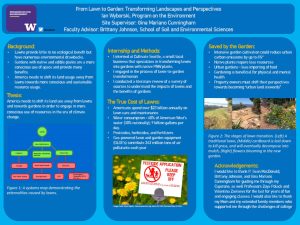From Lawn to Garden: Transforming Landscapes and Perspectives
As the impacts of climate change become more evident and resources become scarcer, it is now more important than ever to make conscious use of our resources. Lawns are ubiquitous in suburban America and are a symbol of the middle class but are and provide little to no environmental benefit. I sought to investigate the environmental impacts that lawns have, and how we can better utilize our land and water through the cultivation of gardens. For my capstone, I worked with the small business Cultivate Seattle to learn how lawns can be converted into gardens and learn hands-on gardening skills, as well as conducted a literature review to understand environmental threats presented by traditional lawns. My that lawns pose many problems, bringing into question their continued presence in American landscapes. Lawns in arid regions require intensive irrigation, which is becoming increasingly unfeasible due to ongoing water shortages in many states; the pesticides, herbicides, and fertilizers commonly used on lawns can contain carcinogenic compounds and an overabundance of nutrients which can have profoundly negative effects on local waterways; the use of gas-powered lawn care equipment, like all other machines that run on fossil fuels, emit carbon and harmful compounds such as volatile organic compounds (VOCs). Increased development of gardens can help us to avoid these externalities. Gardens, especially those with native and edible plants, provide habitat for pollinators and other wildlife, can reduce strain on urban food systems, and are significantly less resource consumptive than lawns.
